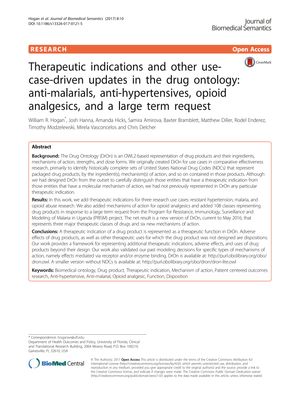Therapeutic Indications and Use-Case-Driven Updates in the Drug Ontology: Anti-Malarials, Anti-Hypertensives, Opioid Analgesics, and a Large Term Request
March 2017
in “
Journal of Biomedical Semantics
”

TLDR The Drug Ontology was updated to better classify drugs for hypertension, malaria, and opioid abuse, and to allow for more accurate research queries.
In 2017, Hogan et al. updated the Drug Ontology (DrOn) to include therapeutic indications for drugs used in treating resistant hypertension, malaria, and opioid abuse, as well as the mechanisms of action for opioid analgesics. The update involved adding 108 new classes based on a term request and allowed DrOn to distinguish between a drug's therapeutic functions and broader dispositions, such as off-label uses or adverse effects. The ontology, which was current as of May 2016, now supports more accurate research analyses by enabling queries based on drug characteristics. The paper also highlighted the ontology's extensibility for representing additional therapeutic indications and adverse effects, and the use of the dron-query tool for querying drug products. However, the updates were limited to specific research use cases and did not cover clinical uses or pharmacogenomics, with future work planned for further comparison with other systems and representation of additional drug information.
